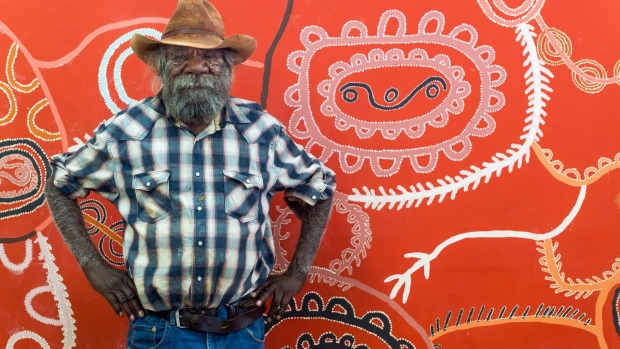
The sun-bleached scene is straight out of an Albert Namatjira painting: a dry creek bed in an ochre landscape dotted with rocky outcrops and stately ghost gums.
But we're not at Hermannsburg, the former Lutheran mission near Alice Springs where the celebrated Aboriginal artist produced his pastel-hued watercolours, but 500 kilometres to the south, where Namatjira's great-grandson, Vincent, has settled after a turbulent early life marked by family tragedy and cultural dislocation.
The 32-year-old is among a new generation of Central Desert artists whose work will be one of the highlights of the inaugural Festival of Contemporary Aboriginal and Torres Strait Islander Art in Adelaide next month. He lives at Indulkana, one of a dozen communities sprinkled across the remote, beautiful and troubled Anangu Pitjantjatjara Yankunytjatjara (APY) Lands in South Australia's far north-west.
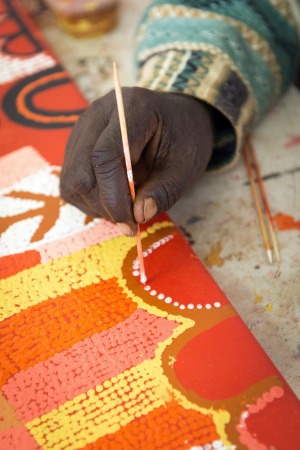
It's an area which, as a lover of Aboriginal desert art, I've been hankering to visit for years. Now I'm rattling along a rough gravel road with the manager of Indulkana's art centre, Beth Conway, who whips up clouds of red dust as she expertly dodges potholes and a pack of wild horses skittering across our path.
We're travelling with Nici Cumpston, the festival's artistic director, and Nick Mitzevich, director of the Art Gallery of South Australia. The event is being choreographed by the gallery in partnership with 29 other cultural institutions, including the state library, Adelaide's JamFactory and the Museum of Economic Botany. With 27 exhibitions, as well as workshops, symposiums and an art fair, a city with an already bulging festival calendar will be "living and breathing Aboriginal art ... You won't be able to miss it," promises Mitzevich.
The new festival, running from October 8-18, is called Tarnanthi ("tar-nan-dee"), which in the Kaurna language of the Adelaide Plains describes the dawning of first light or a young seed sprouting. Much of the content has been commissioned from new, and Cumpston says it will illustrate the extraordinary diversity of indigenous art-making today, from painting and ceramics to photography, textiles, print-making, tjanpi (spinifex grass weaving) and punu (wood carving).
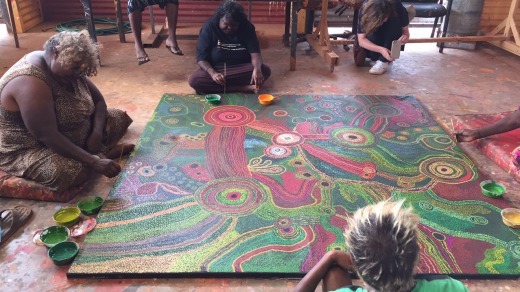
While work from all over the country will be showcased, about a third of the 300-plus artists live in the Central Desert. In recent times, the sparsely populated APY Lands have gained increasing prominence, with senior men such as Hector Burton, from Amata community, ranked among Australia's most eminent and collectible Aboriginal artists. At last month's Telstra Art Award, the nation's richest and most prized indigenous art competition, APY artists Betty Pumani and Robert Fielding – both from Mimili community – won two of the five subsidiary prizes.
One of a wave of younger artists confounding and captivating the art world, Vincent Namatjira picked up a paintbrush only in 2011, but has already been shortlisted for half a dozen awards, including two Telstras. His paintings hang in the Queensland Art Gallery and also in the British Museum, which exhibited a portrait of Captain Cook in its recent blockbuster show Indigenous Australia: Enduring Civilisation.
Vincent's bold, graphic works – wry commentaries on politics and black Australia – could hardly be more different from his famous ancestor's Western-style landscapes, or from the densely layered dot paintings of traditional desert art. "I'm proud to be a Namatjira, and my [great-]grandfather is a hero to me," he says, chatting in Indulkana's airy art centre, Iwantja Arts. "But I want to do things differently. I want to take that Namatjira name and broaden it a bit."
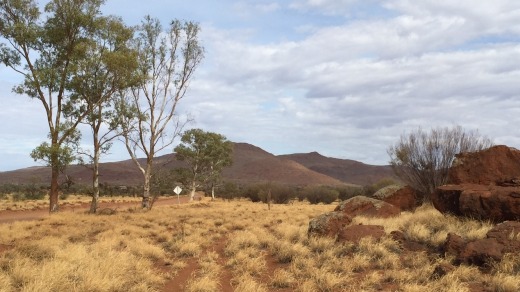
A rangy figure with a gangsta swagger and a gap-toothed grin, Vincent spent his early years at Hermannsburg but was brought up in foster care in Perth after his mother died when he was six. As a young adult, he returned to Central Australia, reconnected with family and married an Indulkana woman, Natasha Pompey. Their eldest daughter, 11-year-old Amelia, has already achieved commercial success. "She did a dot painting," says Vincent, "and one of the teachers at the school bought it."
His work will feature in one of Tarnanthi's headline exhibitions, Desert Salon, as will that of fellow Indulkana artist Tiger Yaltangki, whose quirky, engaging paintings – drawing on popular culture as well as traditional spirit imagery – are creating a buzz almost equal to Namatjira's. Yaltangki accompanies us to Iwantja Creek, a lovely, tranquil spot shaded by twisted white eucalypts. A large gum tree marks the site where Tjurki, the owl, rested during his Dreamtime travels.
Indulkana used to be part of the sprawling Everard Park cattle station, where men such as Peter Mungkuri, a senior artist, worked as stockmen and ringers. Like many of the older men, Mungkuri is nostalgic for those days and still dresses the part, in checked shirt, Akubra and ancient cowboy boots. Another former station man, Jimmy Pompey, paints vivid scenes of stockmen corralling cattle.
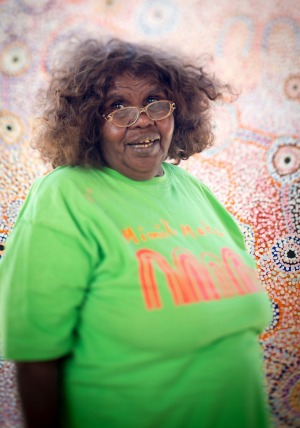
An hour's drive to the west lies Mimili, a pretty community cradled by clusters of rust-red boulders. The art centre, Mimili Maku, looks like a Jackson Pollock painting, with its floors, walls and chairs spattered with splodges of pink and orange and cream. Maku means witchetty grub, which is found beneath the roots of mulga trees in the area. It's also a sacred story, inspiring artists such as Tuppy Goodwin. "It's my mother's Dreaming, and it belongs to me and my sister," Goodwin says.
The Musgrave Ranges, with their soft green and pink tones, are bathed in early morning light when we arrive at Pukatja community, formerly known as Ernabella. The art centre is reputedly Australia's oldest, and the first person through the door is Gordon Ingkatji, a dapper 85-year-old with a ready chuckle.
Ingkatji lived naked in the desert with his parents until he was eight – only then, he recounts, did he first see whitefellas. After a mission was established at Ernabella, he helped to build the church, dug wells, made fences and taught the Pitjantjatjara language, An esteemed artist, he is also a preacher and ngangkari (traditional healer).
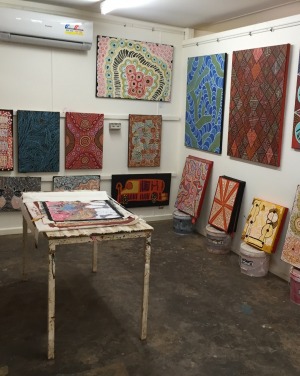
Our last stop is Amata, nicknamed "Amata Dramata" because of its violent reputation. There's no hint of such problems, though, at Tjala Arts, which is a hive of purposeful activity. Teenage relatives watch intently as five sisters apply green dots to a huge collaborative painting depicting the Tjala, or Honey Ant Dreaming. Keeping young people gainfully occupied, and passing on Tjukurpa, or significant cultural stories, are key functions of these community-owned and -governed art centres.
At Tjala, culture is "kept alive and celebrated and transmitted on a daily basis", says the manager, Skye O'Meara. Hector Burton explains: "It's Anangu [Aboriginal people] way, always from the grandfather to the grandson, and that's alive today at Tjala." Burton's brother, Willy Kaika, shows off an armful of carved wooden spears, among hundreds destined for an outdoor installation at Tarnanthi. The Kulata Tjuta (Many Spears) project, which the pair conceived as a way of engaging young men and passing on traditional knowledge and skills, has spread across the Lands.
As well as an art-making studio, Tjala is a social hub. Tousle-haired kids run around shrieking, and scrawny dogs on the hunt for food are periodically shoved outside, only to sneak back in. Outside, in the red dirt yard, where elders sit companionably in the shade, a fire has been built and kangaroo tails wrapped in foil are baking.
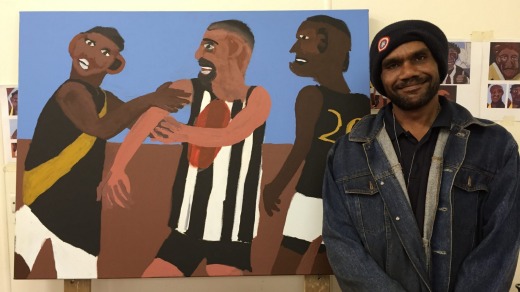
The APY's seven art centres, says Nick Mitzevich, are "an amazing success story", providing communities with not only an income but a sense of pride, and an alternative narrative to alienation and dysfunction. "The young people see their elders selling paintings and going off to exhibitions in Sydney and Melbourne, and that success enthuses them," he observes.
I'm feeling pretty enthused myself. For outsiders, though, the Lands present many challenges. Permits are needed to visit the communities, which are exceedingly isolated – after flying into Uluru or Alice Springs, expect a lengthy drive, much of it on unsealed roads. Apart from the odd roadhouse, there is little accommodation. And while Iwantja and Ernabella welcome visitors, other art centres are less accessible.
Tarnanthi – and particularly its art fair, which many of the artists will attend – offers a short cut, suggests Mitzevich. "All the communities will have stalls there, so it's a great access point and a way to broaden your understanding. You'll be able to see the variety and dynamism of Aboriginal art right now."
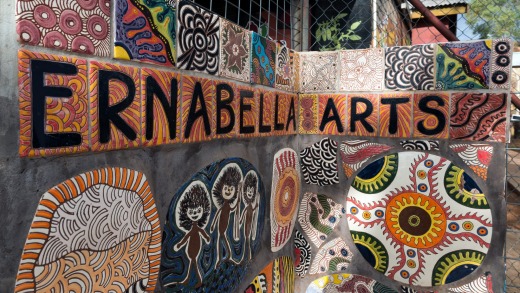
The principal exhibitions, which will run until mid-January, include a retrospective of the Riverland weaver Yvonne Koolmatrie, sculpture by the Torres Strait artist Brian Robinson, and paintings from Spinifex Country, in Western Australia's south-east. The Desart Photography Prize, which has brought to prominence young artists such as Amata's Rhonda Dick, will also form part of the festival.
Organisers hope Tarnanthi will become a fixture on Adelaide's cultural timetable, and a new destination for Aboriginal art lovers and collectors - joining established drawcards such as the Western Australian Indigenous Art Awards, Desert Mob in Alice Springs and the Cairns Indigenous Art Fair.
In 1939, South Australia's state gallery became the first public institution to acquire an Aboriginal work – an Albert Namatjira painting. Now the premier, Jay Weatherill, wants the state to become "the international hub for Aboriginal visual art". With the excitement surrounding Tarnanthi, and all the talent sloshing around the APY Lands, that doesn't seem an unrealistic aspiration.
www.southaustralia.com
www.tarnanthi.com.au
All of the major airlines operate frequent flights from Sydney and Melbourne to Adelaide. See www.qantas.com.au, www.virginaustralia.com, www.jetstar.com, www.tigerair.com.
Mayfair Hotel, 45 King William St, is a short walk from the Art Gallery of South Australia. Rooms start at $194 a night. Phone (08) 8210 8888, see www.mayfairhotel.com.au.
The Festival of Contemporary Aboriginal and Torres Strait Islander Art, known as Tarnanthi, runs from October 8-18, with most activities focused on the two weekends. The major exhibitions continue into January.
Peel Street, 9 Peel St. Phone (08) 8231 8887, see peelst.com.au; 2KW, 8, 2 King William St. Phone (08) 8212 5511, see 2kwbar.com.au; Africola, 4 East Terrace. Phone (08) 8223 3885, see www.africola.com.au.